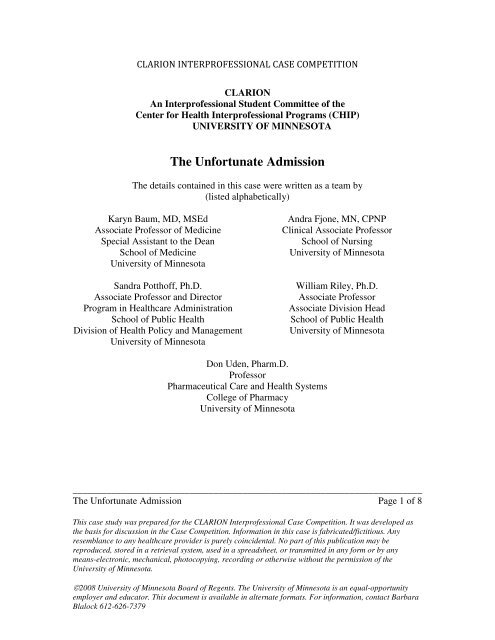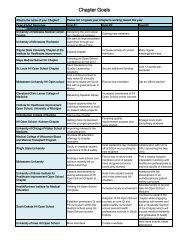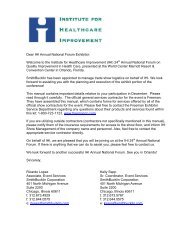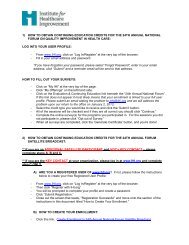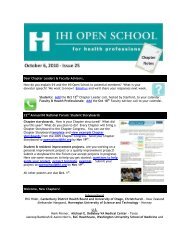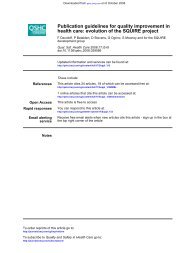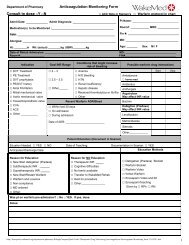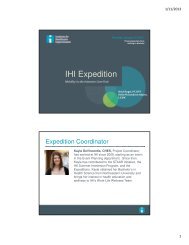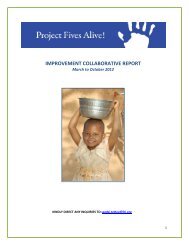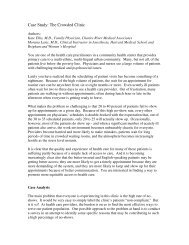The Unfortunate Admission - Institute for Healthcare Improvement
The Unfortunate Admission - Institute for Healthcare Improvement
The Unfortunate Admission - Institute for Healthcare Improvement
Create successful ePaper yourself
Turn your PDF publications into a flip-book with our unique Google optimized e-Paper software.
CLARION<br />
An Interprofessional Student Committee of the<br />
Center <strong>for</strong> Health Interprofessional Programs (CHIP)<br />
UNIVERSITY OF MINNESOTA<br />
<strong>The</strong> <strong>Un<strong>for</strong>tunate</strong> <strong>Admission</strong><br />
<strong>The</strong> details contained in this case were written as a team by<br />
(listed alphabetically)<br />
Karyn Baum, MD, MSEd<br />
Associate Professor of Medicine<br />
Special Assistant to the Dean<br />
School of Medicine<br />
University of Minnesota<br />
Sandra Potthoff, Ph.D.<br />
Associate Professor and Director<br />
Program in <strong>Healthcare</strong> Administration<br />
School of Public Health<br />
Division of Health Policy and Management<br />
University of Minnesota<br />
Andra Fjone, MN, CPNP<br />
Clinical Associate Professor<br />
School of Nursing<br />
University of Minnesota<br />
William Riley, Ph.D.<br />
Associate Professor<br />
Associate Division Head<br />
School of Public Health<br />
University of Minnesota<br />
Don Uden, Pharm.D.<br />
Professor<br />
Pharmaceutical Care and Health Systems<br />
College of Pharmacy<br />
University of Minnesota<br />
________________________________________________________________________<br />
<strong>The</strong> <strong>Un<strong>for</strong>tunate</strong> <strong>Admission</strong> Page 1 of 8<br />
This case study was prepared <strong>for</strong> the CLARION Interprofessional Case Competition. It was developed as<br />
the basis <strong>for</strong> discussion in the Case Competition. In<strong>for</strong>mation in this case is fabricated/fictitious. Any<br />
resemblance to any healthcare provider is purely coincidental. No part of this publication may be<br />
reproduced, stored in a retrieval system, used in a spreadsheet, or transmitted in any <strong>for</strong>m or by any<br />
means-electronic, mechanical, photocopying, recording or otherwise without the permission of the<br />
University of Minnesota.<br />
2008 University of Minnesota Board of Regents. <strong>The</strong> University of Minnesota is an equal-opportunity<br />
employer and educator. This document is available in alternate <strong>for</strong>mats. For in<strong>for</strong>mation, contact Barbara<br />
Blalock 612-626-7379
Sentinel Event<br />
Day One<br />
Jane Nagel is an 18-year-old woman who presented to the emergency department (ED) at<br />
5 p.m. complaining that she was “not feeling well.” She told the admitting staff she had<br />
nasal congestion, stuffiness, sore throat and a cough <strong>for</strong> the last couple weeks. She also<br />
had achy joints and chest discom<strong>for</strong>t on the right side. In fact, her cough led her to quit<br />
smoking <strong>for</strong> two weeks. She had not been drinking or eating much during the last few<br />
days, and she said her urine was darker than usual.<br />
Mary Wood, RN obtained her vital signs in the ED. Her temperature was 95.4°F and<br />
pulse was 83 beats per minute. Her blood pressure was 102/59 mmHg, respirations were<br />
16 breaths per minute and oxygen saturation was 100 percent on room air.<br />
James Hall, M.D., saw her in the emergency room. He obtained the above history and<br />
learned she had stopped her Plaquenil about two months ago (the physicians complete the<br />
medicine reconciliation process in the Emergency Department). Jane told the doctor that<br />
it had not helped control her lupus, so she had decided to quit taking it without consulting<br />
her physician.<br />
Jane’s SLE (lupus) was diagnosed two years ago when she presented with an array of<br />
symptoms and findings that included joint pain, blood in her urine, chest discom<strong>for</strong>t and a<br />
positive double-stranded DNA and ANA. A rheumatologist saw her initially and has<br />
followed her care intermittently since the initial diagnosis. However Jane often is unable<br />
to go to her appointments because of her lack of transportation. Because the hospital and<br />
clinic have recently converted to an electronic health record (EHR), only the last nine<br />
months’ worth of appointments are available (the rest are in the paper clinic chart, which<br />
is located in the clinic).<br />
Jane’s physical examination was essentially normal, although James Hall, M.D., thought<br />
she appeared mildly dehydrated. He ordered some intravenous normal saline. Her chest<br />
x-ray was read by James Hall, M.D., as clear and was unchanged compared to one done<br />
at the same hospital just three weeks ago. This x-ray had been done in the ED when Jane<br />
had presented <strong>for</strong> chest pain, which was ultimately attributed to her lupus. She had been<br />
advised to see her rheumatologist but had not made the appointment. To assist with<br />
diagnosing her chief complaints, multiple blood and urine laboratory tests were ordered<br />
during this visit to the ED.<br />
________________________________________________________________________<br />
<strong>The</strong> <strong>Un<strong>for</strong>tunate</strong> <strong>Admission</strong> Page 2 of 8<br />
This case study was prepared <strong>for</strong> the CLARION Interprofessional Case Competition. It was developed as<br />
the basis <strong>for</strong> discussion in the Case Competition. In<strong>for</strong>mation in this case is fabricated/fictitious. Any<br />
resemblance to any healthcare provider is purely coincidental. No part of this publication may be<br />
reproduced, stored in a retrieval system, used in a spreadsheet, or transmitted in any <strong>for</strong>m or by any<br />
means-electronic, mechanical, photocopying, recording or otherwise without the permission of the<br />
University of Minnesota.<br />
2008 University of Minnesota Board of Regents. <strong>The</strong> University of Minnesota is an equal-opportunity<br />
employer and educator. This document is available in alternate <strong>for</strong>mats. For in<strong>for</strong>mation, contact Barbara<br />
Blalock 612-626-7379
James Hall, M.D., planned to discharge Ms. Nagel after the IV fluids were administered,<br />
but he decided to admit her to the hospital when she told him that her pain was very<br />
similar to the pain that lead to her lupus diagnosis two years ago. He agreed with Jane’s<br />
suggestion that she might be having a flare of her disease because she stopped taking her<br />
medication. James Hall, M.D., told the attending general medicine physician he<br />
recommended she be admitted.<br />
Upon admission to the General Medicine Unit, Grant Thompson, M.D., the intern on call,<br />
obtained some additional history. Jane was also diagnosed as bipolar disorder and had<br />
been admitted nine months ago to a psychiatric unit in a hospital in the same system <strong>for</strong> a<br />
suicide attempt. Jane lives in a sober house after completed treatment <strong>for</strong> drug abuse. She<br />
has some biological family but was placed in the foster-care system <strong>for</strong> six years after<br />
being removed from her mother’s house because of her mother’s drug addiction. Her<br />
older sister also suffers from drug and alcohol addiction. Jane denied using any street<br />
drugs or alcohol.<br />
<strong>The</strong> complete physical examination done by Grant Thompson, M.D., was normal. Her<br />
white blood count, hemoglobin and electrolytes were all within normal ranges. Grant<br />
ordered multiple other laboratory tests, a urine toxicology screen and a pregnancy test.<br />
He also ordered a psychiatry consult because Jane had told him that she had not been<br />
seeing a therapist or psychiatrist nor taking any medications <strong>for</strong> her bipolar disorder.<br />
About 9 p.m., Jane’s laboratory work was completed. Her erythrocyte sedimentation rate<br />
was 73 mm/h (normal 0-20 mm/h). <strong>The</strong> nasal swab <strong>for</strong> influenza, rapid streptococcal<br />
screen and urine pregnancy test were negative.<br />
Grant Thompson, M.D., briefly discussed the case over the phone with the attending<br />
physician Marc Cash, M.D. <strong>The</strong>y agreed that the likely diagnosis was a flare of her lupus<br />
with a complicating systemic viral or urinary track infection. <strong>The</strong>y decided to restart her<br />
Plaquenil, start prednisone at 20mg per day and consult rheumatology the next day. Grant<br />
wrote this order on his way home at 9:30 p.m.<br />
At 10 p.m. the pharmacy received the orders, and James Miller, Pharm.D., reviewed the<br />
orders. He wrote a note to ask when Jane had her last eye exam. Because he wanted to<br />
follow-up on the patient’s history, James decided not to fill the Plaquenil that night, since<br />
it was written as “qday.” He sent up the prednisone dose.<br />
________________________________________________________________________<br />
<strong>The</strong> <strong>Un<strong>for</strong>tunate</strong> <strong>Admission</strong> Page 3 of 8<br />
This case study was prepared <strong>for</strong> the CLARION Interprofessional Case Competition. It was developed as<br />
the basis <strong>for</strong> discussion in the Case Competition. In<strong>for</strong>mation in this case is fabricated/fictitious. Any<br />
resemblance to any healthcare provider is purely coincidental. No part of this publication may be<br />
reproduced, stored in a retrieval system, used in a spreadsheet, or transmitted in any <strong>for</strong>m or by any<br />
means-electronic, mechanical, photocopying, recording or otherwise without the permission of the<br />
University of Minnesota.<br />
2008 University of Minnesota Board of Regents. <strong>The</strong> University of Minnesota is an equal-opportunity<br />
employer and educator. This document is available in alternate <strong>for</strong>mats. For in<strong>for</strong>mation, contact Barbara<br />
Blalock 612-626-7379
Day Two<br />
Jane had a restless night and did not sleep well. <strong>The</strong> night nurse found a sleeper chair <strong>for</strong><br />
her boyfriend, who had spent the night in her room.<br />
When Grant Thompson, M.D., arrived at 7:30 a.m. the next morning, he reviewed her<br />
vital signs and the morning laboratory work prior to seeing her. Jane had received a total<br />
of 1.5 liters of normal saline since admission.<br />
Her urinalysis showed 10mg/dl ketones, 3 squamous epithelial cells/high power field,<br />
trace leukocyte esterase, 11 WBC/ high power field and mucous. Consistent with a lupus<br />
flare, Jane’s complement concentrations were a C3 of 51mg/dl (90-200), a C4 of 4mg/dl<br />
(15-50) and a CH50 of 22mg/dl (60-144). <strong>The</strong> sputum gram stain showed mixed grampositive<br />
and gram-negative organisms with less than10 squamous epithelial cells/low<br />
power field. Her blood culture was negative at less than 24 hours. Her urine toxicology<br />
screen was positive <strong>for</strong> acetaminophen, caffeine and opiates. Grant Thompson checked<br />
the ED note and did not see any note that they had given her opiates <strong>for</strong> pain.<br />
Grant Thompson, M.D., saw Jane on patient rounds. She was lying in her hospital bed<br />
with her boyfriend. Grant believed Jane looked better than the previous day. <strong>The</strong><br />
rheumatologist who saw her later that day also felt that she had a lupus flare with a<br />
concomitant viral infection. Grant and the attending physician discussed Jane’s case.<br />
Both believed she should be ready <strong>for</strong> discharge by the next day. <strong>The</strong>y agreed she should<br />
be started on levofloxacin <strong>for</strong> a urinary tract infection. Thompson noted the need <strong>for</strong> the<br />
antibiotic in his daily documentation.<br />
About 10 a.m. Jo Forsyth, Pharm.D., the pharmacist <strong>for</strong> the day, called Grant Thompson,<br />
M.D., to ask about Jane’s last eye exam. Grant didn’t know when the appointment was.<br />
After talking with Jo, they decided to start the medication but wrote an order <strong>for</strong> an<br />
ophthalmologist exam be<strong>for</strong>e Jane was discharged. Grant noted the order on the sheets<br />
that he carries in his pocket <strong>for</strong> each patient to remind himself to order an exam.<br />
At 4 p.m., Grant Thompson, M.D., noticed that no psychiatry note was on the chart. He<br />
asked the nurse, Jackie Billings, RN, if someone from the consult team had seen Jane.<br />
Jackie did not think so. Grant double-checked to ensure the order had been removed by<br />
the Health Unit Coordinator the day be<strong>for</strong>e. His check showed the order was removed.<br />
He was certain he had called the psychiatry department and left a message requesting the<br />
consult. Psychiatry staff do not give out a pager number or name of a physician. Instead,<br />
________________________________________________________________________<br />
<strong>The</strong> <strong>Un<strong>for</strong>tunate</strong> <strong>Admission</strong> Page 4 of 8<br />
This case study was prepared <strong>for</strong> the CLARION Interprofessional Case Competition. It was developed as<br />
the basis <strong>for</strong> discussion in the Case Competition. In<strong>for</strong>mation in this case is fabricated/fictitious. Any<br />
resemblance to any healthcare provider is purely coincidental. No part of this publication may be<br />
reproduced, stored in a retrieval system, used in a spreadsheet, or transmitted in any <strong>for</strong>m or by any<br />
means-electronic, mechanical, photocopying, recording or otherwise without the permission of the<br />
University of Minnesota.<br />
2008 University of Minnesota Board of Regents. <strong>The</strong> University of Minnesota is an equal-opportunity<br />
employer and educator. This document is available in alternate <strong>for</strong>mats. For in<strong>for</strong>mation, contact Barbara<br />
Blalock 612-626-7379
they only have a telephone with an answering machine. This is how all consult requests<br />
must be made.<br />
Frustrated by the lack of response by the psychiatry department, Grant Thompson, M.D.,<br />
called the hospital operator to obtain the name of someone to page. He finally managed<br />
to reach the administrative assistant of the psychiatry department. She said the<br />
department didn’t have a record of the consult request. She said they’d had some<br />
problems with the answering machine. She connected Grant with one of the staff<br />
psychiatrists, who recommended that Jane follow-up as an outpatient since she was not<br />
actively suicidal. He gave Grant a phone number to give to Jane so she could schedule an<br />
appointment. Angry about this lapse in care, Grant left after spending 45 minutes on this<br />
issue. In his haste to leave, he <strong>for</strong>got to write the order <strong>for</strong> the levofloxacin.<br />
It was Friday, and Tracey Wells, M.D., was covering <strong>for</strong> the attending physician Marc<br />
Cash, M.D., that weekend. Marc discussed the patients over the phone with the Tracey<br />
and indicated he thought Jane was improving and she should be discharged tomorrow.<br />
At 6 p.m., Beth Mirrow, LPN, noticed that Jane’s vital signs indicated that she had a<br />
fever of 101.3°F and a pulse of 118 beats per minute. Beth called the on-call intern who<br />
ordered another set of blood cultures and recommended that acetaminophen be given <strong>for</strong><br />
the fever. Beth ensured the orders were complete, and Jane’s temperature decreased in<br />
one hour. <strong>The</strong> on-call intern did not have a chance to write down this in<strong>for</strong>mation and her<br />
decisions to order the culture and medication and <strong>for</strong>got to pass it along to Grant<br />
Thompson, M.D., the next morning<br />
Day Three<br />
Jane felt worse on Saturday morning. After her shift was finished, Kim Franklin, RN,<br />
entered Jane’s morning vital signs at 7:19 a.m., which were a temperature of 101.3°F,<br />
pulse of 140 beats per minute, blood pressure of 105/46, respirations of 30 breaths per<br />
minute, and oxygen saturation of 93 percent on room air. She made a note in the<br />
electronic vitals section that “report was given to AM shift <strong>for</strong> intervention.”<br />
Grant Thompson, M.D., came in to work on Saturday at 7 a.m. He was hoping to get<br />
finished and leave a little early to enjoy the good weather. Jane was the first person he<br />
saw. Her boyfriend was once again in the bed with her. Jane was sleepy but otherwise her<br />
exam was noted to be normal. It is not clear whether or not he checked her morning vital<br />
________________________________________________________________________<br />
<strong>The</strong> <strong>Un<strong>for</strong>tunate</strong> <strong>Admission</strong> Page 5 of 8<br />
This case study was prepared <strong>for</strong> the CLARION Interprofessional Case Competition. It was developed as<br />
the basis <strong>for</strong> discussion in the Case Competition. In<strong>for</strong>mation in this case is fabricated/fictitious. Any<br />
resemblance to any healthcare provider is purely coincidental. No part of this publication may be<br />
reproduced, stored in a retrieval system, used in a spreadsheet, or transmitted in any <strong>for</strong>m or by any<br />
means-electronic, mechanical, photocopying, recording or otherwise without the permission of the<br />
University of Minnesota.<br />
2008 University of Minnesota Board of Regents. <strong>The</strong> University of Minnesota is an equal-opportunity<br />
employer and educator. This document is available in alternate <strong>for</strong>mats. For in<strong>for</strong>mation, contact Barbara<br />
Blalock 612-626-7379
signs or those from the evening be<strong>for</strong>e. Although that in<strong>for</strong>mation is on the computer,<br />
there is no way to determine who accessed the in<strong>for</strong>mation.<br />
Len Cameron, LPN, learned about Jane’s temperature from Kim Franklin, RN. This was<br />
his third shift on the Medical/Surgical ward. He had just been hired after working <strong>for</strong><br />
three years at a local transitional care facility. Per her standing orders, Len gave Jane<br />
some of the “as needed” acetaminophen as well as an oxycodone <strong>for</strong> the right-sided chest<br />
pain about which Jane had started complaining. He rechecked her vital signs at 9:11 a.m.<br />
Her temperature decreased to 100.4°F, and her pulse was 123 beats per minute. He saw<br />
that she had blood cultures drawn the previous evening so he did not call the intern and<br />
discuss Jane’s status.<br />
Grant Thompson, M.D., and the covering attending physician, Tracey Wells, M.D.,<br />
discussed Jane’s case at 9 a.m. Grant mistakenly reported yesterday’s vital signs to<br />
Tracey. During their discussion about Jane, Grant realized that he had <strong>for</strong>gotten to write<br />
the antibiotic order. He was afraid to tell Tracey because she had a reputation <strong>for</strong> being<br />
very hard on interns. <strong>The</strong>y decided Jane could be discharged, and Grant wrote the orders.<br />
Len Cameron, LPN took the discharge <strong>for</strong>ms and went over them with Jane. She said that<br />
she felt poorly, was having some trouble breathing and really did not want to go. Len<br />
called Grant Thompson, M.D., and told him that “the patient does not feel ready to go<br />
home” but did not convey any other in<strong>for</strong>mation to Grant or give his opinion. Grant told<br />
Len that Jane had already stayed an extra day because of the mix-up with the psychiatry<br />
consult. Len was unsure when to call an attending physician and didn’t want to get the<br />
intern in trouble. He told Jane that the medical staff felt that she could go home. She was<br />
discharged at 10 a.m. and then took the bus home.<br />
At 11 a.m., Grant Thompson, M.D., finished rounding, writing orders <strong>for</strong> his patients and<br />
went home. Grant double-checked Jane’s initial blood cultures drawn in the ED. Those<br />
cultures remained negative. He did not see that blood cultures had been drawn the<br />
previous evening. Laboratory tests that do not have reported results (such as the cultures<br />
from the previous night) do not show up in the laboratory section on the new EHR unless<br />
you click “show pending” next to the tests you want to see. Grant is a new user of the<br />
EHR and didn’t know which tab to click. Since it was Saturday, Grant could not make<br />
the ophthalmology appointment. Clinic scheduling is open from Monday through Friday.<br />
Instead, he wrote the phone number <strong>for</strong> them on Jane’s discharge orders.<br />
________________________________________________________________________<br />
<strong>The</strong> <strong>Un<strong>for</strong>tunate</strong> <strong>Admission</strong> Page 6 of 8<br />
This case study was prepared <strong>for</strong> the CLARION Interprofessional Case Competition. It was developed as<br />
the basis <strong>for</strong> discussion in the Case Competition. In<strong>for</strong>mation in this case is fabricated/fictitious. Any<br />
resemblance to any healthcare provider is purely coincidental. No part of this publication may be<br />
reproduced, stored in a retrieval system, used in a spreadsheet, or transmitted in any <strong>for</strong>m or by any<br />
means-electronic, mechanical, photocopying, recording or otherwise without the permission of the<br />
University of Minnesota.<br />
2008 University of Minnesota Board of Regents. <strong>The</strong> University of Minnesota is an equal-opportunity<br />
employer and educator. This document is available in alternate <strong>for</strong>mats. For in<strong>for</strong>mation, contact Barbara<br />
Blalock 612-626-7379
At 12:15 p.m., the microbiology laboratory technician paged the on-call intern, Jeff<br />
Splaine, M.D. <strong>The</strong> blood cultures drawn the previous evening were both positive <strong>for</strong><br />
gram-negative bacteria, indicating Jane had a bacteremia and was potentially sepsis. <strong>The</strong><br />
intern went to the medical unit and quickly looked through Jane’s records to determine<br />
her status at discharge. Concerned <strong>for</strong> her, at 1 p.m. he called Jane at the Sober House<br />
and asked her how she was feeling. She told him that she was exhausted, coughing and<br />
felt warm and sweaty. Jeff advised her to immediately come back to the hospital.<br />
Jane told him that she had just gotten home and was exhausted. She had no car or ride<br />
and did not have enough energy to walk back to the bus stop. Jeff Splaine, M.D., placed<br />
her on hold and tried to find out if the hospital could pay <strong>for</strong> a cab. <strong>The</strong> charge nurse at<br />
the front desk said there was not a mechanism to get that done. Jeff apologized to Jane<br />
and said he didn’t think a cab was possible. He emphasized the need <strong>for</strong> her to come right<br />
back and go directly to the Medicine Care Unit.<br />
Jane finally arrived at the hospital by bus at 7:15 p.m. and was immediately admitted to<br />
the Medicine Care Unit. She was clearly exhausted, flushed and diaphoretic. At 7:23<br />
p.m., her vital signs were a temperature of 104.7°F, pulse of 149 beats per minute, blood<br />
pressure of 100/38 mmHg, respirations of 40 breaths per minute, and oxygen saturation<br />
of 92 percent. Jeff Splaine, M.D., examined her within a few minutes of her arrival and<br />
quickly concluded that she was in septic shock. He and the nursing staff immediately<br />
transferred her to the Medical Intensive Care Unit and began multiple intravenous<br />
antibiotics including ceftriaxone, vancomycin and levofloxacin.<br />
Jane had not taken any of the medications, including the levofloxacin, given upon<br />
discharge because she was worn out and slightly nauseated.<br />
Jane rapidly decompensated during the next two hours. She progressed into acute<br />
respiratory distress, had to be intubated and placed on a ventilator. Her chest x-ray<br />
revealed new airspace opacities in both lungs consistent with bilateral pneumonia or<br />
acute respiratory distress syndrome. Her blood pressure dropped and multiple<br />
vasopressors were started to maintain her blood pressure.<br />
Despite heroic measures, her blood pressure could not be stabilized. Jane died at 2:12<br />
p.m. the next day.<br />
________________________________________________________________________<br />
<strong>The</strong> <strong>Un<strong>for</strong>tunate</strong> <strong>Admission</strong> Page 7 of 8<br />
This case study was prepared <strong>for</strong> the CLARION Interprofessional Case Competition. It was developed as<br />
the basis <strong>for</strong> discussion in the Case Competition. In<strong>for</strong>mation in this case is fabricated/fictitious. Any<br />
resemblance to any healthcare provider is purely coincidental. No part of this publication may be<br />
reproduced, stored in a retrieval system, used in a spreadsheet, or transmitted in any <strong>for</strong>m or by any<br />
means-electronic, mechanical, photocopying, recording or otherwise without the permission of the<br />
University of Minnesota.<br />
2008 University of Minnesota Board of Regents. <strong>The</strong> University of Minnesota is an equal-opportunity<br />
employer and educator. This document is available in alternate <strong>for</strong>mats. For in<strong>for</strong>mation, contact Barbara<br />
Blalock 612-626-7379
<strong>The</strong> blood cultures from the evening of the second day of her hospitalization grew<br />
Hemophilus influenzae. Her autopsy revealed bilateral gram-negative pneumonia with<br />
bacteremia and multi-organ failure, likely from septic shock.<br />
________________________________________________________________________<br />
<strong>The</strong> <strong>Un<strong>for</strong>tunate</strong> <strong>Admission</strong> Page 8 of 8<br />
This case study was prepared <strong>for</strong> the CLARION Interprofessional Case Competition. It was developed as<br />
the basis <strong>for</strong> discussion in the Case Competition. In<strong>for</strong>mation in this case is fabricated/fictitious. Any<br />
resemblance to any healthcare provider is purely coincidental. No part of this publication may be<br />
reproduced, stored in a retrieval system, used in a spreadsheet, or transmitted in any <strong>for</strong>m or by any<br />
means-electronic, mechanical, photocopying, recording or otherwise without the permission of the<br />
University of Minnesota.<br />
2008 University of Minnesota Board of Regents. <strong>The</strong> University of Minnesota is an equal-opportunity<br />
employer and educator. This document is available in alternate <strong>for</strong>mats. For in<strong>for</strong>mation, contact Barbara<br />
Blalock 612-626-7379


